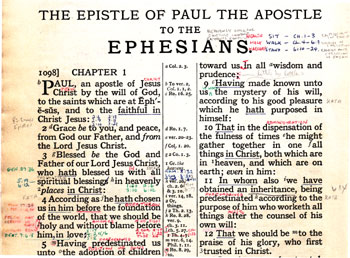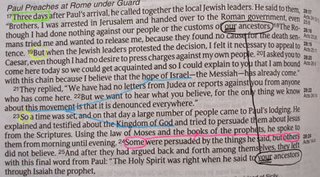As you are reading your Bible at home you might see something about the words that strike you as interesting, or you are listening to a teaching and as you follow it in your Bible something catches your attention. This is the Spirit of God pointing to something He wants you to understand. “No one comprehends the thoughts of God except the Spirit of God. Now we have received not the spirit of the world, but the Spirit who is from God, that we might understand the things freely given us by God” (I Corinthians 2:11b-12 ESV).
Now be honest, will you remember what is was that caught your attention a day later? Will you remember where in the Word it was? D.L. Moody, the “Billy Graham” of the late 1800s, wrote in his book Golden Counsels (1899), “Unless you have an uncommon memory, you cannot retain the good things you hear. If you trust to your ear alone, they will escape you in a day or two; but, if you mark your Bible, and enlist the aid of your eye, you will never lose them.”
 So let’s talk about Bible marking, a common practice in Moody’s day but rarely mentioned now. Today in many churches the scripture texts are placed on a screen, enhancing the “spectator” attitude to the service and giving the impression that you don’t need a Bible; “come just as you are!” As a young Christian, I saw many fellow believers write in their Bibles.
So let’s talk about Bible marking, a common practice in Moody’s day but rarely mentioned now. Today in many churches the scripture texts are placed on a screen, enhancing the “spectator” attitude to the service and giving the impression that you don’t need a Bible; “come just as you are!” As a young Christian, I saw many fellow believers write in their Bibles.
In 2004 I was privileged to inspect the KJV Bible used by E.W. Kenyon, and it was well marked. Moody wisely wrote, “Do not buy a Bible that you are unwilling to mark and use.”
My own KJV Bible that I’ve used for about 50 years is marked, particularly in books like Ephesians where the pages are grubby and ready to fall out. I notice that I used fine ballpoint pens (not gel ink), red, green, and blue in color, to contrast with the black type, and also some pencil marks, 2B or 3B. A large-print Bible, say 9.1/4″ x 6″, is best as you can write words between the lines. You can also buy wide-margin Bibles.
I have mentioned before that for study a “literal” translation is best, such as the ESV or KJV, while a paraphrase or mixture of both has value for illustrative purposes. I’m not a “King James Only” teacher, but it does have the most reference works published on any version.
It’s time for some examples. I’m concentrating on the words in the Word, not on topics. There are many suggested systems that assign a color to a topic. The problem is your Bible will start to look like a rainbow and it is hard to remember which topic goes with a specific color. I suggest you give topics a miss for a while and read the books of the Bible as they were written, chapter by chapter.
Suppose you decide to read through Ephesians in the ESV, so you start with chapter one verse one. You notice the two “in” prepositions and you wonder why. The saints are both “in Ephesus” and “in Christ Jesus;” in two positions or locations at the one time (see page 168, Completely Satisfied in Christ by Peter Wade). You could perhaps underline the two “in’s” or circle them. Of course, some have digital versions and you’ll have to work out for yourself how to mark the text, perhaps highlighting or underlining. So that example is a repetition of words in the same verse.
Later you read verses 18-19 of chapter 1, “Having the eyes of your hearts enlightened, that you may know…” (ESV). There are two “what” words in the rest of the verse and another one in verse 19. Each usage signifies the start of an indirect question, so you could place the numbers 1, 2, and 3 in front of each “what” respectively. You can know in reality these three great truths. In fact, your heart (the seat of your personal life in your brain) has been enlightened so you can know these things. That’s an example of a list, but it is not clearly seen in the way the type is set in your Bible until you mark it. There’s another list in chapter 2, verses 5 and 6.
 Another technique is called a “railway connection,” a thin line underlining one statement and then connected the start of the underline of a second statement. In KJV chapter 2, verse 2, “in time past;” verse 3, “in times past;” verse 11, “in time past;” and then verse 13, “But now…” See another way of doing this in the illustration, circling the phrase and joining the two usages (from NLT).
Another technique is called a “railway connection,” a thin line underlining one statement and then connected the start of the underline of a second statement. In KJV chapter 2, verse 2, “in time past;” verse 3, “in times past;” verse 11, “in time past;” and then verse 13, “But now…” See another way of doing this in the illustration, circling the phrase and joining the two usages (from NLT).
Try out these suggested methods, read Moody’s full article online at WholesomeWords.org, which has other good examples, and retain all the revelation God gives you as you read His word and listen to His promptings.



Peter: Loved this teaching back then and I love it now…my bible is well marked although not as organized…I mark with whatever I have available…(grin).
Love, Christ as Geri
Good to hear that. When I think about it, I can’t remember in all the times we’ve met seeing the inside of your Bible! But then, there’s lots of things I can’t seem to remember. Love in Christ, Peter